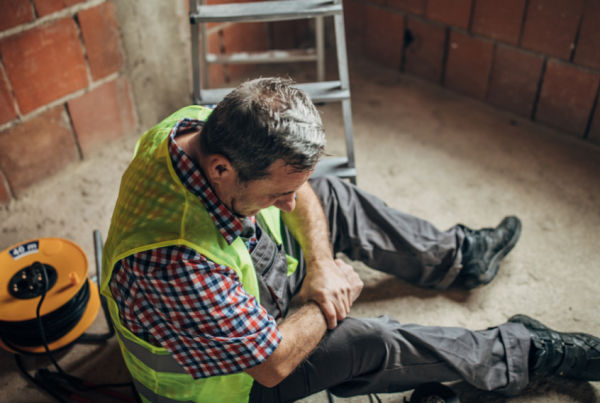Mobility Concerns
Move Better. Live Fuller. Your Wellness Journey Starts Here.
Schedule a FREE Discovery Call!
Structures of the body that most commonly cause mobility problems include the joints, spine, muscles, tendons, and nervous system. Therefore, mobility problems often occur with the following areas of the body:
- Knees
- Hips
- Shoulders
- Ankles
- Wrists and hands
- Neck
- Lower back
Mobility limitations can be created by all kinds of things—such as injury, congenital conditions, chronic conditions, disease, and the aging process. In fact, mobility problems can involve a wide variety of cases. For example, a person who has injured their foot will have mobility struggles. Or in another case, an individual may find walking or climbing stairs more difficult as they age. For some, mobility limitations may be something caused by congenital disabilities.
No matter the cause of your mobility concerns, physical therapy can improve your overall function and comfort, allowing you to move more freely. Before we jump into the ways that physical therapy can offer these benefits, let’s explore some more specific examples of things that cause mobility limitations.
What Causes Reduced Mobility?
There are many things that can impact mobility. For many people, reduced mobility can be a combination of factors that affect their ability to walk, move, and perform activities. Below, we’ll explore a variety of factors that may reduce your mobility, strength, flexibility, or joint range of motion.
Injuries and Pain
Injuries and bodily pains are a common cause of reduced mobility—not just temporarily, but also long-term. While many individuals can maintain good mobility, function, and range of motion after an injury with proper treatment, many fail to undergo the necessary rehabilitation and therapy needed to restore their body to optimal health. Some common injuries or locations of pain that can impact your long-term mobility include the following:
- Fractures: Frequently occur in the hips, ankles, or wrists. Fractures in these areas can affect your ability to walk, sit, or hold items.
- Whiplash: Can create neck pain and limited range of motion.
- Shoulder injuries: Problems with the shoulders such as rotator cuff injuries or frozen shoulder can restrict your range of motion. These injuries may prevent you from lifting items or moving your arm as normal, which can make even the simplest of tasks more difficult.
- Tendon or ligament injuries: Problems with the ligaments or tendons can create stiffness, discomfort, and reduced range of motion. For example, inflammation such as with tendonitis can affect the mobility of the shoulders, knees, wrists, elbows, and more. Ligament injuries commonly occur in the ankles or wrists, often due to falls or impact.
- Hip pain: Your hips play a role in many different movements such as bending, walking, squatting, and running. They serve as an important connection point between the upper body and the legs, so problems with the hips can make it difficult to move comfortably.
- Low back pain: The lower back contributes to many different movements and supports your upper body’s weight. Problems with this area can cause a significant loss in mobility and can even affect your posture.
- Knee pain: Your knees are responsible for absorbing impact from a variety of movements. They help you stand, walk, squat, and more; therefore, problems with the knees can impact daily activities and movement.
Conditions
Many different types of conditions can affect the body’s ability to move. This can range from physical conditions that cause pain or stiffness to neurological conditions that affect balance and coordination. Here are some examples:
- Osteoarthritis: A common form of arthritis that affects the cartilage in the body, which usually serves as a cushion for bones. As this cartilage wears away, it can cause joint damage that results in pain, restricted movement, stiffness, and reduced flexibility.
- Rheumatoid arthritis: An autoimmune disease and form of arthritis that causes pain, swelling, and stiffness of the joints.
- Carpal tunnel syndrome: A common condition of the wrist and hands caused by compression of the median nerve. It creates pain, weakness, and numbness in the hands and fingers.
- Cervical spondylosis: Refers to the wear and tear of the spinal discs located in the neck, which can occur with age. This condition causes stiffness and pain, and may even affect the spinal canal. If this occurs, symptoms can begin to spread to the arms, hands, legs, and feet.
- Herniated discs: The slippage or protrusion of a cushioning disc located between two vertebrae. This structure can push into nerves and create numbness, pain, and dysfunction.
- Degenerative disc disease: This condition refers to when the spinal discs between the vertebrae wear away, causing the vertebrae to rub against each other. This condition creates pain, stiffness, and numbness in the back and legs.
- Neurological disorders: Conditions such as cerebral palsy, Parkinson’s disease, multiple sclerosis, or stroke may affect an individual’s balance, stability, coordination, ability to walk, and mobility.
- Sciatica: A condition affecting the sciatic nerve, which runs from the lower back down both legs. Compression or irritation of this nerve causes pain, numbness, or weakness in the legs.
- Spinal stenosis: This condition refers to a narrowing of the spinal canal, which can put pressure on the spinal cord and nerves. It can cause pain, tingling, and muscle weakness.
Surgeries
There are many reasons that an individual may undergo surgery. While procedures such as knee surgery or hip surgery can restore function and comfort for a variety of cases, they can sometimes create other problems in the body. Here are some examples:
- In some cases, surgical interventions may create the formation of adhesions and scar tissue. These both form as a result of healing, but may become restrictive if not addressed properly. Scar tissue and adhesions can pull surrounding tissue which may limit mobility and cause pain.
- While in most cases surgeries aim to provide restored mobility and comfort, some individuals may fail to properly engage in rehabilitative therapy and exercise following their procedure. This can lead to stiffness, low function, and reduced range of motion.
- As with any surgery, there are risks. In rare cases, surgery may affect the nerves, ligaments, or other tissues needed for movement. In terms of replacement surgeries, implant failure is possible, but not very common.
Lifestyle and Aging
Your lifestyle choices play a major role in your health and long-term mobility. Having a sedentary lifestyle can significantly impact your mobility and even contribute to many of the conditions or injuries listed earlier. Failing to engage in regular physical activity can create weakness in the muscles, reducing their strength and your ability to enjoy activities. Every movement requires muscle strength—even just walking or standing up. No matter your age, regular activity is a crucial part of good health.
Keeping your muscles strong and your joints loose is essential for long-term comfort and mobility. Moving often and exercising regularly can keep your joints lubricated and capable of motion. Not only does regular physical exercise keep you feeling good and moving well, but it can also prevent a multitude of health complications.
This is especially important due to the fact that your body changes with age. With aging comes changes in hormones, lower muscle mass, reduced bone strength and density, and other aspects that are considered a “normal” part of aging. Individuals who practice regular exercise and healthy diets are shown to have significantly better mobility as they age, and lower risk of complications or injuries. While you can’t necessarily avoid aging, you can support your body as it experiences changes associated with the aging process!
Physical Therapy for Improving Mobility
Mobility changes are a part of life—you’ll likely experience a variety of factors that change how you move throughout your life. However, experiencing life events that impact your mobility doesn’t mean you have to give up on doing things you love. By engaging in physical therapy, you can enhance your function, strength, and flexibility, which will improve your quality of life overall.
Improvements to mobility can depend on a variety of factors; your age, causes of mobility concerns, lifestyle, and other needs. Regardless, your Hive physical therapist will work hard to improve your quality of life by reducing your pain, improving your function, and enhancing your overall mobility. If necessary, your physical therapist can collaborate with other health professionals in order to better integrate your physical therapy treatment with other forms of treatment that you may receive, such as surgery, medication, and more.
To begin, your physical therapist will first discuss with you any previous surgeries, injuries, conditions, or other medical histories that are relevant to your mobility and needs. They will question your daily needs, and how your restrictions or symptoms affect your movements, activities, work, and more. Next, they’ll perform a physical examination to gain a better understanding of your current level of mobility and where the restrictions originate. This can include an examination of your:
- Posture while sitting or standing
- Movement patterns
- Gait (walking patterns)
- Transitions, such as from sitting to standing and vice versa
- Muscle strength or balance
- Joint range of motion
- Ability to perform certain tasks or movements, such as climbing stairs
After a thorough examination, your physical therapist will create a treatment plan based on your individual needs and current abilities. Your care plan may include a variety of treatments that will improve both your mobility and ability to perform tasks. Some common treatments used to address mobility concerns include the following examples:
Correcting Posture, Form, and Mechanics
Maintaining proper posture and practicing good form during activity is essential to preventing injury and supporting movement. Your physical therapist will have determined any weaknesses in your posture during your physical examination. With these weaknesses in mind, your physical therapist will curate a routine of activities and exercises that will correct postural imbalances. You can expect to learn proper postures while bending over, lifting items, walking, standing, and more.
Maintaining good posture is essential for preventing muscle and joint dysfunctions, which can disrupt your range of motion, flexibility, and overall mobility.
Improving Strength and Flexibility
In order to support good posture and function, your muscles will need to be strong and coordinated. Muscle weakness leads to low function, straining, and difficulty with daily activities. To promote healthy function and movement, your physical therapist will create an exercise and stretching plan that best suits your needs. This plan may include goals such as the following:
- Strengthening the abdominals, hips, legs, lower back, and pelvic floor to support good posture and your ability to lift, walk, and run.
- Strengthening the back, arms, and shoulders to support good posture, your ability to hold and lift items, and your range of motion for turning, twisting, bending, and so on.
- Improving coordination between the back, hips, abdominals, and pelvic floor to encourage better muscle activation and improve your movement mechanics for a variety of activities.
- Strengthening the chest, shoulders, and arms to enhance your ability to push, pull, or lift.
- Whole-body stretching to encourage flexibility and tissue mobility, which can prevent strains and improve movement for the entire body.
The providers at Hive Therapy and Wellness believe in comprehensive and holistic treatment—meaning your exercise plan won’t simply target singular muscle groups. Your physical therapist knows how to best engage and improve coordination of multiple muscle groups. While receiving treatment with Hive, you can expect to engage in a variety of activities and exercises that best support your needs and long-term health!
Pain Management
Low muscle strength, joint mobility, or overall movement can contribute to a variety of painful conditions and injuries. Your Hive physical therapist will be able to address your pain with a variety of treatments! They offer many different pain-relieving treatments that can improve muscle function, strength, and relaxation. This includes things like electrical muscle stimulation, TENS, tissue scraping, dry needling, cupping, hands-on techniques, and more.
Many of these manual therapies work by manipulating tissues such as muscles, nerves, tendons, ligaments, and more. This gentle manipulation relieves tightness, reduces pain, and increases blood flow. Manual therapy can improve joint mobility, address scar tissue, and target painful trigger points. There’s tons of benefits to these treatments, and they work great when paired with exercises and other treatment methods!
Education
Lastly, education will play a major role in your treatment and long-term success. Your Hive physical therapist can help you understand why your body changes with age, how treatment can support better mobility, and even teach you about the pain neuroscience. Your physical therapist can even provide you with plenty of advice for at-home care, such as:
- Strategies to enhance your posture and mobility, such as changes to your home or work environment.
- Suggestions for tools or mobility aids, such as canes, walkers, and more.
- Lifestyle changes such as modifying behaviors that may be harming your posture or mobility.
In addition to the treatments described above, there are many other ways that a physical therapist can restore your mobility and comfort. The providers at Hive Therapy and Wellness will create an individualized care plan based on your unique needs, current level of mobility, and medical history. With professional treatment and consistency, you can improve your quality of life, move better, and return to doing things you enjoy! To achieve these goals, your Hive physical therapist may utilize any of the following treatment methods in your care plan:
- Neuromuscular re-education
- Manual therapy
- Exercise prescription
- Dry needling
- Cupping
- Tissue scraping
- Behavioral modifications
- Therapeutic activities
- Electrical muscle stimulation
- Spinal manipulation
- Therapeutic modalities
- Biofeedback
Mobility is an essential part of life that allows you to move, walk, and perform daily activities. Mobility can look different for everyone, and can change as you age and experience changes to your health or lifestyle.
However, some aspects of health can create limitations on mobility that prevent you from moving freely or engaging in your usual daily tasks.
Problems with mobility can make it difficult to walk, stand up from sitting positions, roll over, lift objects, and much more. Limitations can be temporary, or they can be long-term.
Depending on the cause, your mobility concerns may include symptoms such as pain, weakness, reduced range of motion, or loss of function.
Structures of the body that most commonly cause mobility problems include the joints, spine, muscles, tendons, and nervous system. Therefore, mobility problems often occur with the following areas of the body:
- Knees
- Hips
- Shoulders
- Ankles
- Wrists and hands
- Neck
- Lower back
Mobility limitations can be created by all kinds of things—such as injury, congenital conditions, chronic conditions, disease, and the aging process. In fact, mobility problems can involve a wide variety of cases. For example, a person who has injured their foot will have mobility struggles.
Or in another case, an individual may find walking or climbing stairs more difficult as they age. For some, mobility limitations may be something caused by congenital disabilities.
No matter the cause of your mobility concerns, physical therapy can improve your overall function and comfort, allowing you to move more freely.
Before we jump into the ways that physical therapy can offer these benefits, let’s explore some more specific examples of things that cause mobility limitations.
There are many things that can impact mobility. For many people, reduced mobility can be a combination of factors that affect their ability to walk, move, and perform activities.
Below, we’ll explore a variety of factors that may reduce your mobility, strength, flexibility, or joint range of motion.
Injuries and Pain
Injuries and bodily pains are a common cause of reduced mobility—not just temporarily, but also long-term.
While many individuals can maintain good mobility, function, and range of motion after an injury with proper treatment, many fail to undergo the necessary rehabilitation and therapy needed to restore their body to optimal health.
Some common injuries or locations of pain that can impact your long-term mobility include the following:
Fractures: Frequently occur in the hips, ankles, or wrists. Fractures in these areas can affect your ability to walk, sit, or hold items.
Whiplash: Can create neck pain and limited range of motion.
Shoulder injuries: Problems with the shoulders such as rotator cuff injuries or frozen shoulder can restrict your range of motion. These injuries may prevent you from lifting items or moving your arm as normal, which can make even the simplest of tasks more difficult.
Tendon or ligament injuries: Problems with the ligaments or tendons can create stiffness, discomfort, and reduced range of motion. For example, inflammation such as with tendonitis can affect the mobility of the shoulders, knees, wrists, elbows, and more. Ligament injuries commonly occur in the ankles or wrists, often due to falls or impact.
Hip pain: Your hips play a role in many different movements such as bending, walking, squatting, and running. They serve as an important connection point between the upper body and the legs, so problems with the hips can make it difficult to move comfortably.
Low back pain: The lower back contributes to many different movements and supports your upper body’s weight. Problems with this area can cause a significant loss in mobility and can even affect your posture.
Knee pain: Your knees are responsible for absorbing impact from a variety of movements. They help you stand, walk, squat, and more; therefore, problems with the knees can impact daily activities and movement.
Conditions
Many different types of conditions can affect the body’s ability to move. This can range from physical conditions that cause pain or stiffness to neurological conditions that affect balance and coordination. Here are some examples:
Osteoarthritis: A common form of arthritis that affects the cartilage in the body, which usually serves as a cushion for bones. As this cartilage wears away, it can cause joint damage that results in pain, restricted movement, stiffness, and reduced flexibility.
Rheumatoid arthritis: An autoimmune disease and form of arthritis that causes pain, swelling, and stiffness of the joints.
Carpal tunnel syndrome: A common condition of the wrist and hands caused by compression of the median nerve. It creates pain, weakness, and numbness in the hands and fingers.
Cervical spondylosis: Refers to the wear and tear of the spinal discs located in the neck, which can occur with age. This condition causes stiffness and pain, and may even affect the spinal canal. If this occurs, symptoms can begin to spread to the arms, hands, legs, and feet.
Herniated discs: The slippage or protrusion of a cushioning disc located between two vertebrae. This structure can push into nerves and create numbness, pain, and dysfunction.
Degenerative disc disease: This condition refers to when the spinal discs between the vertebrae wear away, causing the vertebrae to rub against each other. This condition creates pain, stiffness, and numbness in the back and legs.
Neurological disorders: Conditions such as cerebral palsy, Parkinson’s disease, multiple sclerosis, or stroke may affect an individual’s balance, stability, coordination, ability to walk, and mobility.
Sciatica: A condition affecting the sciatic nerve, which runs from the lower back down both legs. Compression or irritation of this nerve causes pain, numbness, or weakness in the legs.
Spinal stenosis: This condition refers to a narrowing of the spinal canal, which can put pressure on the spinal cord and nerves. It can cause pain, tingling, and muscle weakness.
Surgeries
There are many reasons that an individual may undergo surgery. While procedures such as knee surgery or hip surgery can restore function and comfort for a variety of cases, they can sometimes create other problems in the body.
Here are some examples:
- In some cases, surgical interventions may create the formation of adhesions and scar tissue. These both form as a result of healing, but may become restrictive if not addressed properly. Scar tissue and adhesions can pull surrounding tissue which may limit mobility and cause pain.
- While in most cases surgeries aim to provide restored mobility and comfort, some individuals may fail to properly engage in rehabilitative therapy and exercise following their procedure. This can lead to stiffness, low function, and reduced range of motion.
- As with any surgery, there are risks. In rare cases, surgery may affect the nerves, ligaments, or other tissues needed for movement. In terms of replacement surgeries, implant failure is possible, but not very common.
Lifestyle and Aging
Your lifestyle choices play a major role in your health and long-term mobility. Having a sedentary lifestyle can significantly impact your mobility and even contribute to many of the conditions or injuries listed earlier.
Failing to engage in regular physical activity can create weakness in the muscles, reducing their strength and your ability to enjoy activities. Every movement requires muscle strength—even just walking or standing up.
No matter your age, regular activity is a crucial part of good health.
Keeping your muscles strong and your joints loose is essential for long-term comfort and mobility. Moving often and exercising regularly can keep your joints lubricated and capable of motion.
Not only does regular physical exercise keep you feeling good and moving well, but it can also prevent a multitude of health complications.
This is especially important due to the fact that your body changes with age. With aging comes changes in hormones, lower muscle mass, reduced bone strength and density, and other aspects that are considered a “normal” part of aging.
Individuals who practice regular exercise and healthy diets are shown to have significantly better mobility as they age, and lower risk of complications or injuries.
While you can’t necessarily avoid aging, you can support your body as it experiences changes associated with the aging process!
Mobility changes are a part of life—you’ll likely experience a variety of factors that change how you move throughout your life.
However, experiencing life events that impact your mobility doesn’t mean you have to give up on doing things you love. By engaging in physical therapy, you can enhance your function, strength, and flexibility, which will improve your quality of life overall.
Improvements to mobility can depend on a variety of factors; your age, causes of mobility concerns, lifestyle, and other needs. Regardless, your Hive physical therapist will work hard to improve your quality of life by reducing your pain, improving your function, and enhancing your overall mobility.
If necessary, your physical therapist can collaborate with other health professionals in order to better integrate your physical therapy treatment with other forms of treatment that you may receive, such as surgery, medication, and more.
To begin, your physical therapist will first discuss with you any previous surgeries, injuries, conditions, or other medical histories that are relevant to your mobility and needs.
They will question your daily needs, and how your restrictions or symptoms affect your movements, activities, work, and more. Next, they’ll perform a physical examination to gain a better understanding of your current level of mobility and where the restrictions originate.
This can include an examination of your:
- Posture while sitting or standing
- Movement patterns
- Gait (walking patterns)
- Transitions, such as from sitting to standing and vice versa
- Muscle strength or balance
- Joint range of motion
- Ability to perform certain tasks or movements, such as climbing stairs
After a thorough examination, your physical therapist will create a treatment plan based on your individual needs and current abilities.
Your care plan may include a variety of treatments that will improve both your mobility and ability to perform tasks. Some common treatments used to address mobility concerns include the following examples:
Correcting Posture, Form, and Mechanics
Maintaining proper posture and practicing good form during activity is essential to preventing injury and supporting movement. Your physical therapist will have determined any weaknesses in your posture during your physical examination.
With these weaknesses in mind, your physical therapist will curate a routine of activities and exercises that will correct postural imbalances. You can expect to learn proper postures while bending over, lifting items, walking, standing, and more.
Maintaining good posture is essential for preventing muscle and joint dysfunctions, which can disrupt your range of motion, flexibility, and overall mobility.
Improving Strength and Flexibility
In order to support good posture and function, your muscles will need to be strong and coordinated. Muscle weakness leads to low function, straining, and difficulty with daily activities.
To promote healthy function and movement, your physical therapist will create an exercise and stretching plan that best suits your needs. This plan may include goals such as the following:
- Strengthening the abdominals, hips, legs, lower back, and pelvic floor to support good posture and your ability to lift, walk, and run.
- Strengthening the back, arms, and shoulders to support good posture, your ability to hold and lift items, and your range of motion for turning, twisting, bending, and so on.
- Improving coordination between the back, hips, abdominals, and pelvic floor to encourage better muscle activation and improve your movement mechanics for a variety of activities.
- Strengthening the chest, shoulders, and arms to enhance your ability to push, pull, or lift.
- Whole-body stretching to encourage flexibility and tissue mobility, which can prevent strains and improve movement for the entire body.
The providers at Hive Therapy and Wellness believe in comprehensive and holistic treatment—meaning your exercise plan won’t simply target singular muscle groups.
Your physical therapist knows how to best engage and improve coordination of multiple muscle groups. While receiving treatment with Hive, you can expect to engage in a variety of activities and exercises that best support your needs and long-term health!
Pain Management
Low muscle strength, joint mobility, or overall movement can contribute to a variety of painful conditions and injuries. Your Hive physical therapist will be able to address your pain with a variety of treatments!
They offer many different pain-relieving treatments that can improve muscle function, strength, and relaxation. This includes things like electrical muscle stimulation, TENS, tissue scraping, dry needling, cupping, hands-on techniques, and more.
Many of these manual therapies work by manipulating tissues such as muscles, nerves, tendons, ligaments, and more. This gentle manipulation relieves tightness, reduces pain, and increases blood flow.
Manual therapy can improve joint mobility, address scar tissue, and target painful trigger points. There’s tons of benefits to these treatments, and they work great when paired with exercises and other treatment methods!
Education
Lastly, education will play a major role in your treatment and long-term success. Your Hive physical therapist can help you understand why your body changes with age, how treatment can support better mobility, and even teach you about the pain neuroscience.
Your physical therapist can even provide you with plenty of advice for at-home care, such as:
- Strategies to enhance your posture and mobility, such as changes to your home or work environment.
- Suggestions for tools or mobility aids, such as canes, walkers, and more.
- Lifestyle changes such as modifying behaviors that may be harming your posture or mobility.
In addition to the treatments described above, there are many other ways that a physical therapist can restore your mobility and comfort. The providers at Hive Therapy and Wellness will create an individualized care plan based on your unique needs, current level of mobility, and medical history.
With professional treatment and consistency, you can improve your quality of life, move better, and return to doing things you enjoy! To achieve these goals, your Hive physical therapist may utilize any of the following treatment methods in your care plan:
- Neuromuscular re-education
- Manual therapy
- Exercise prescription
- Dry needling
- Cupping
- Tissue scraping
- Behavioral modifications
- Therapeutic activities
- Electrical muscle stimulation
- Spinal manipulation
- Therapeutic modalities
- Biofeedback
You can learn more about these treatments on our Treatments Page.






